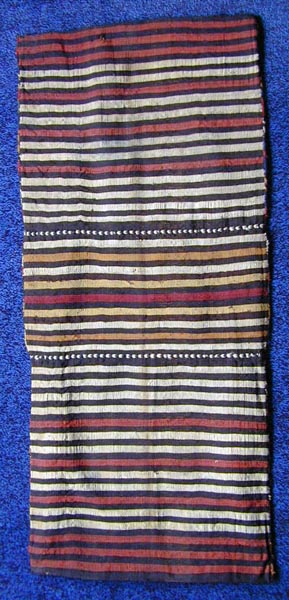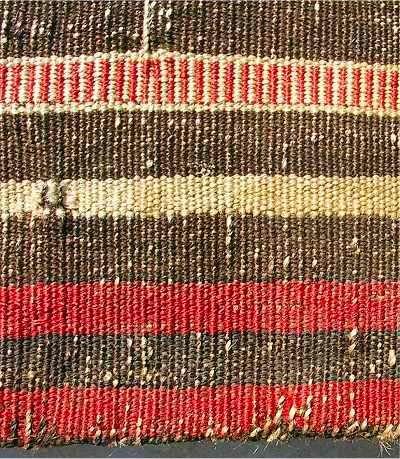Posted by Filiberto Boncompagni on 09-28-2005 05:53 AM:
Zakatala Flat-weaves
Dear all,
When I first met this double bag

I thought it was
odd: I never saw a typical “Shirvan” design with a “dragon” or “S” border. Well,
for that matter I didn’t recall any “dragon” border – one of my favorites - on a
flatweave.
The colors of the bag seemed good, no difference between the
inside and the outside, a sign of probably natural dyes. I bought it.
I still
thought it was a Shirvan bag, until I got Nooter’s “Flat Woven Rugs &
Textiles from the Caucasus”.
The book shows at page 214 another bag with
dragon borders:

said to be
“Khorjin, Zakatala region”. This is how Nooter justifies the attribution:
“The Khorjin shown in Plate 197 was collected by a Turkish dealer in
Zakatala, where he reported that he saw a number of other pieces of similar
design…
Elena Tsareva found a close parallel in the Russian Ethnographic
Museum that was purchased by Miller in 1908 in the village of Khaltan in the
Kuba district and attributed to Tats. Zakatala has a large (fifty-four percent)
Avar population, as well as twenty-eight percent Azeris (Wright/Wertime, 1995,
128). There is no reason to question the Zakatala origin of this piece, but
whether it was woven by Avar, Tats, or Azeris is unknown.”
I would
add to the equations more ethnic groups. According to HALI’s contributing editor
Tony Hazledine who actually went there in 1994 Zakatala (also spelled Zakataly)
is the name given to both the district and the main town. The district is in
Northern Azerbaijan, is composed of around fifty villages and had a population
of about 100,000 of whom 60% Daghestani (Avar, Lesghi, Zeikhuri [my note:
Tsakhurs?] and Kumyk), 30% Azeri, 10% of Georgian Muslims and a former presence
of Armenians which had left because of the turmoil between Armenia and
Azerbaijan. There are 28 different dialects spoken in the area.
The article
was published in HALI 78. Zakatala was already discussed here:
http://www.turkotek.com/salon_00110/s110_t10.htm
(Salon
110 – Thread “Rug for identification” by Lloyd Kannenberg).
Could my bag
be from Zakatala? In other words, can a “dragon” border similarity be enough for
an attribution? No, not really. Are there other similarities? Perhaps the
palette, but Nooter’s photo looks like it was taken with incandescent light (the
supposed ivory color is too yellow, for example) and it’s very difficult to make
a comparison.
Size and structure? Nooter’s is 22”x 54”, mine is 23”x53”
(59x135 cm). Nooter’s has 12 warps and 40 wefts per inch, mine has 14-15 warps e
40 wefts per inch.
That’s close enough. Then there are the backs. As Nooter
notes, “the design and colors of the backs of mafrashes and Khorjins can
sometimes provide a significant clue as to origins.”
The back of
mine:

and Nooter’s:

Well, if
we forget the interesting bridge on Nooter’s one, they look quite similar, what
do you think? My bag has ivory or mixed brown/ivory wool warps, they show
clearly in the worn areas. Looking with a magnifying lens at the picture in
Nooter’s book, it appears to be the same for his bag.
But I needed more
examples. There is one in the New England Rug Society online exhibition "To Have
and To Hold".
http://www.ne-rugsociety.org/gallery/bags/bags-navframe.htm
(#23)
said to be from Zakatala, among other factors, also for the “prevalent use of
natural dark brown”. For more convenience, I copy NERS images here. The
front:

the back:

It’s also
interesting to compare NERS’ detail of closure system:

with mine:

Pretty close, aren’t they? But the NERS bag has dark brown
wefts, 48 wefts per inch, it’s smaller and has a rather different palette.
In
search for more examples, I found this one, posted some time ago by Mr. Lloyd
Kannenberg:

Again, a different palette. In any case, I wrote him asking if
he could send me a photo of the back of his bag.
He sent me A LOT of images
of other Zakatala bags, instead. I’ll post them later, leaving you the time to
digest the ones above. 
Now, a better view, with more accurate colors, of my
bag:

Any comment – or any more examples of Zakatala flat weaves are
welcome.
Regards,
Filiberto
Posted by Filiberto Boncompagni on 09-28-2005 09:08 AM:
Well, Lloyd revealed to be a goldmine for Zakatala bags. He sent me photos of
five more bags that were offered to him by a dealer operating in Istanbul. Lloyd
wrote me:
Because all of these pieces have a single source, I am not
convinced that Zakatala bags are commonly found. He may just have been on the
right dock at the right time.
Here are the pictures – as I
understand, Lloyd owns only the first two Khorjins.










He also sent
me the picture of a similar bag sold on eBay:

I guess this
thread must be a quite extensive and unique source of images for this kind of
weaving.
Thanks, Lloyd.
Filiberto
Posted by Lloyd Kannenberg on 10-01-2005 07:10 AM:
Hello Filiberto -
Here is some structural information on the Zakatala
bags in the pictures I sent. They are of moderate size, width about 2 feet (60
cm), length over all 4 to 5 feet (125-150 cm). All use the "cable and loops"
closure system typical of many Caucasian bags, which is quite distinct from the
"loop-flap" closure seen in many Persian bags, with its characteristic row of
small rectangular closure panels. The warps are ivory wool, about 13-15 per
horizontal inch. The faces are weft-faced slit tapestry weave, the backs
weft-faced plainweave, about 48 per vertical inch. The colors seem all natural,
and include a very dark blue, blue-green, maroon, red, red-orange, golden
yellow, ivory or "white", and a dark brown. I'm inclined to regard the more
muted colors as characteristic of earlier bags.
The stripes on the
reverse of these bags are somewhat enigmatic. In some (the bag in the NERS
exhibit, for example), the order of the colors and width of the stripes is
irregular, in others the order (but not necessarily the widths) of the stripes
is carefully controlled so that the color reads the same top-to-bottom as it
does bottom-to-top. Finally, in some bags with stripes of uniform width, they
appear in regular alternating groups. Do these variations have some tribal
significance?
The design motifs seen on the bag faces, such as the
"dragon", the kochak gul, stars, and medallions, are mostly familiar from other
Caucasian weavings, but not necessarily in the context of a khorjin. For me,
anyway, these bags still hold a number of unanswered questions!
Best to
all, Lloyd
Posted by Filiberto Boncompagni on 10-01-2005 09:59 AM:
Hi Lloyd,
We have here ten bags, of which eight backs are also
visible.
Not a big database, but they do seem parts of the same puzzle, with
many elements in common. For example, several of them have a Kochak border.
By the way, Peter F. Stone puts the “Kochak Stripe” among Zakatala
Motifs:

(see TRIBAL & VILLAGE RUGS: THE DEFINITIVE GUIDE TO DESIGN,
PATTERN & MOTIF. page 177)
The most common border, however, is the
“Dragon” one. More precisely, three pieces have 1 (or 2) Dragon border, two
pieces have a 1 (or 2) Kochak border and two bags have both..
Your last bag
has none of above borders but the motif on its faces is the same of that on the
“bridge” on Nooter’s bag.
The backs have mostly color-organized patterns of
stripes, but in NERS one the stripes have no apparent order. The palettes are
mostly the same, but some show no yellow, others don’t have blue…
The
back of mine shows also an oddity: a single stripe with alternated ivory and red
wefts:

In any case these bags show a common style, and I have little
doubts about their provenance.
Thinking about it, it’s also strange that no
other flat-weaves - say, like kilims or mafrashes - have so far emerged from
Zakatala. As far as I know, that is. 
Best
regards,
Filiberto
Posted by Filiberto Boncompagni on 10-05-2005 10:39 AM:
I was thinking that there is something unsatisfactory in the layout of my
bag.
The weaver wanted to put two bands of “Shirvan medallions” and so she
had to compress them vertically. Then, there is only room for one dragon
border.
How would have it looked if the weaver had used only one central,
uncompressed “Shirvan band” with two dragon borders?
A quick and dirty job
with Paint Shop Pro, and I got the answer:

Notice how the
original bag face seems wider than the virtual one, in spite of having the same
dimensions.
Well, after all I prefer the
original.
Regards,
Filiberto
Posted by Don Ruyle on 10-24-2005 02:13 AM:
Hello Filiberto:
May be it was to make it easy to find the coffee in
the morn.
I see a lot more bags in life that are not the same at both ends
than what one would guess from those discussed here. (Most people want to show
their best, I guess.)
Regards,
Don
__________________
Don
Ruyle

























